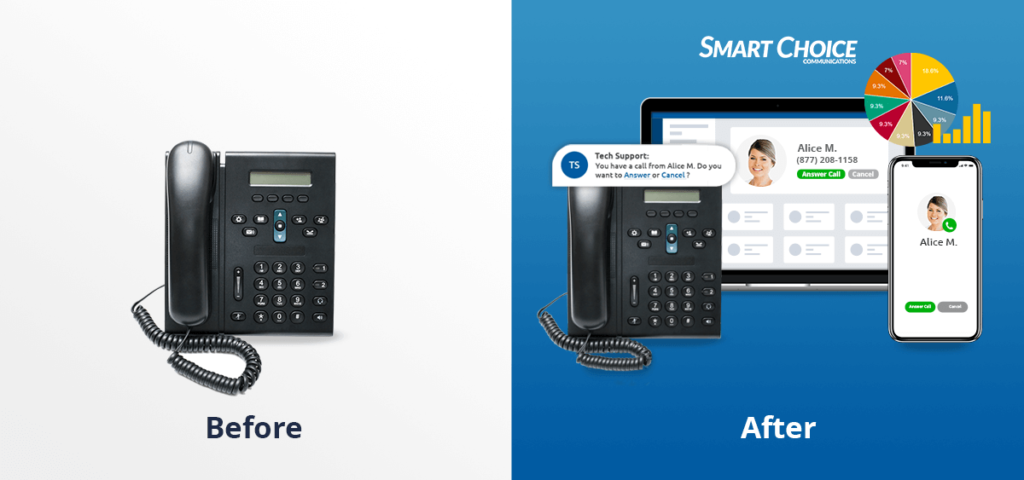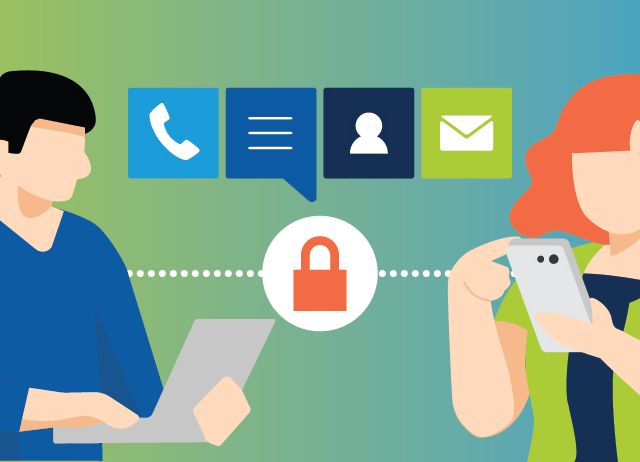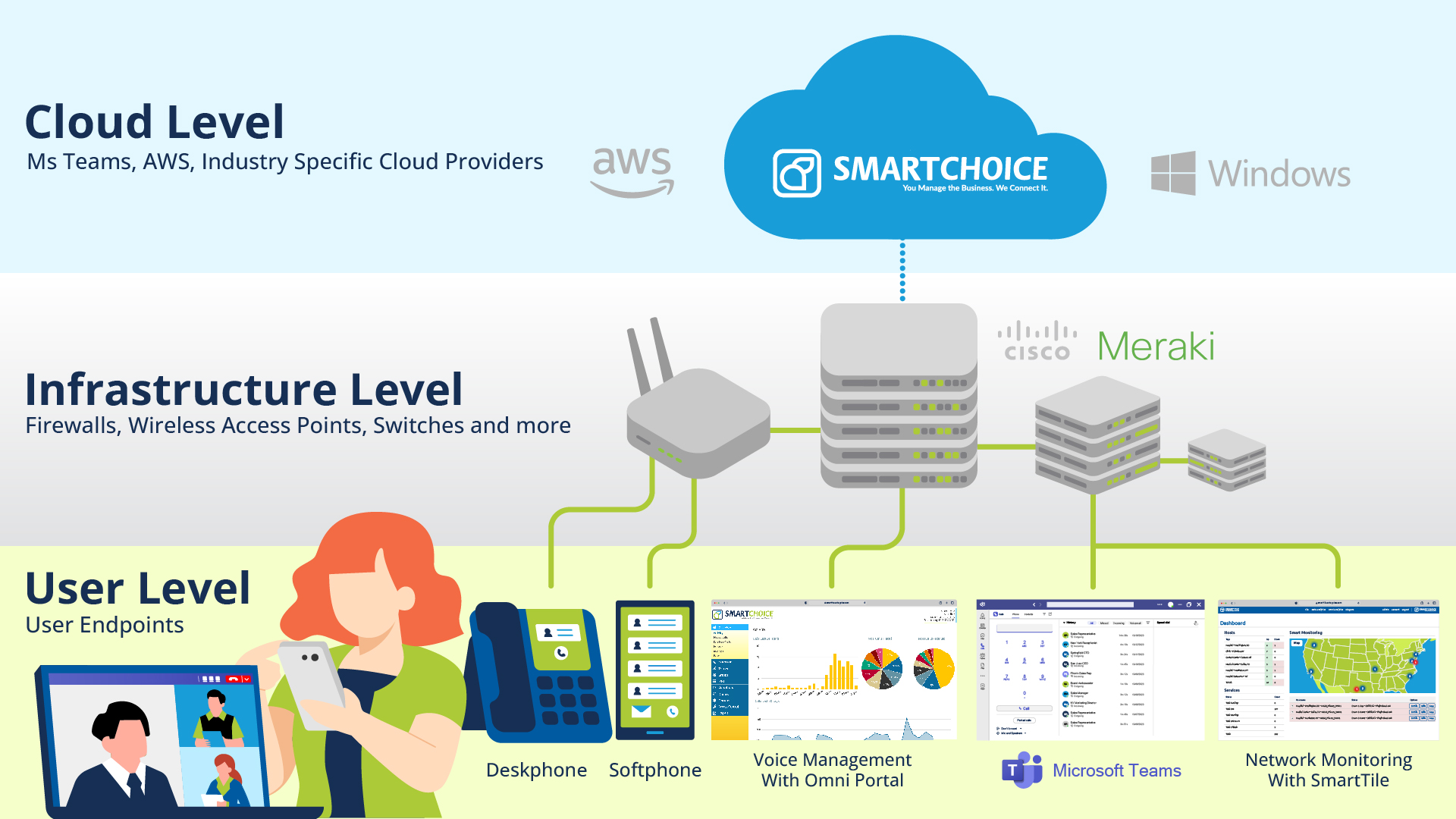Large enterprises, especially those operating across multiple sites and branches, have a wide range of telephony applications and a high demand for feature-rich voice and video solutions.
With legacy PBX once being the gold standard of enterprise communications, the one-size fits all approach no longer fits today’s marketplace. With dynamic company workforces, legacy phone systems are unable to give enterprises the flexibility to adjust their user counts based on their mobility demands.
The need for modernizing enterprise communications is clear. That said, the need for IP phone systems, instant messaging, audio and video conferencing, and integrated collaboration tools adds multiple layers of complexity that each come with their own set of requirements. Before long, the costs start adding up rapidly, and departmental silos arise due to poor interoperability between the various, different systems.
Microsoft Teams is one platform that’s been on many business leaders’ minds lately. While its use exploded with the onset of the coronavirus pandemic, it has proven an invaluable tool in the age of distributed workforces. It is the ultimate collaboration and communication platform, supporting audio and video conferencing, file- and app-sharing, and more.
But what if you have people and applications in your organization that still use analogue modems, or you operate facilities that require overhead paging? What if your existing PBX has advanced telephony features that you can’t function without? Does that mean you have to start over? Fortunately, you don’t, and in this article we’ll explain why.
Can I still use my existing phone system with Microsoft Teams?
In a word, yes. Your PBX system is there to stay, and despite what some companies may try to tell you, there shouldn’t be any need to replace it, especially if it provides critical functionality that works for you.
However, you may also want to take advantage of the collaboration and communication features of Microsoft Teams which, after all, has become one of the most important platforms in the era of remote work. By working with the right integration partner, it’s possible to retain the systems that are already working for you while adding cutting-edge functionality to help modernize your entire communications infrastructure.
The two key ingredients of any integrated PBX infrastructure are the session initiation protocol (SIP) and the enhanced primary rate interface (E-PRI).
The SIP is an essential component of voice over internet protocol (VoIP) communications. It initiates, maintains, and terminates real-time communications, and it supports voice and video calls, conferencing, instant messaging, and media distribution. Most modern phones support the SIP protocol, allowing them to handle calls over the internet, in addition to the conventional landline.
The primary rate interface (PRI) is an older standard that carries voice and data transmissions over the integrated services digital network (ISDN). With the advancement of technology, a lot of enterprises have been replacing their PRI networks with more scalable SIP-based solutions. However, enhanced PRI systems can use both new and existing bandwidth and offer greater resiliency and redundancy without having to replace your entire infrastructure. Each PRI circuit can support up to 23 concurrent calls, none of which depend on data bandwidth for supporting voice calls. Instead, the technology uses the physical copper lines that make up the traditional telephone network. Enhanced PRI builds upon this architecture by using data bandwidth as well, rather than relying solely on antiquated infrastructure.
By integrating Microsoft Teams into the existing on-premises PBX, enterprises can enjoy the revolutionary new features of modern video-conferencing and calling platforms, without having to retire and replace their existing PBX infrastructure. For example, Teams users can handle voice calls to and from legacy devices over SmartChoice’ proprietary E-PRI, while having the freedom to use more advanced features, such as video conferencing, screen share and messaging.
Can I integrate Microsoft Teams without costly upgrades?
A fully integrated and Teams-enabled telephony architecture consists of three main elements:
- An on-premise PBX, along with all supported hardware and infrastructure
- Microsoft Teams with a phone system license.
- Connectivity to PSTN
Summary: You can connect your PSTN with SmartChoice’ proprietary EPRI and SIP cubes.
An integrated solution brings these three elements together via a unified communications (UC) architecture hosted in the cloud. The cloud-based service manages all communications, while centralized operations allow for better disaster recovery and network redundancy. The system can be hosted on any of the major public cloud platforms, including Microsoft Azure, Google Cloud, or Amazon Web Services (AWS).
What this means is you can continue using your existing hardware, including popular business phone systems like those provided by Avaya, Cisco, Mitel, Toshiba, and many more. In other words, you can connect virtually any telephony device to the network, including handsets and mobile phones, as well as softphones, desktops, and laptops running Microsoft Teams. Your employees can continue using both legacy devices and newer, internet-enabled systems to enjoy complete flexibility in almost any environment.
How can I get Microsoft Teams to work with my PBX?
When integrating Microsoft Teams with your PBX, there is no need to forklift your existing infrastructure, but rather maximize the lifespan of your existing infrastructure.
With a fully integrated communications architecture, it is possible to connect practically any endpoint to your network, including:
- Microsoft Teams-certified softphones
- Traditional desk phones and handsets
- Laptop and desktop devices
- Mobile Devices
Moreover, you can continue to use your existing infrastructure, like low-voltage cabling and PBX hardware. There’s no need to upgrade or change your existing carriers and maintenance agreements either, or even pay the costs of physically upgrading your existing phone system. Instead, employees can use their own devices, which is especially valuable for today’s remote workforces. Neither does it matter which network you use for hosting your communications. It will also be possible to record calls, either over SIP or E-PRI. The only difference is that calls over SIP are recorded by path, while E-PRI calls are recorded per PRI channel.
What are the benefits of integrating Microsoft Teams with my PBX?
While some VOIP providers will push for a complete forklift of an enterprise’s entire PBX, it is only reasonable to expect enterprises to want to continue enjoying the best possible return on their investment. Many existing PBX systems are very costly and complicated to implement, and most often still under maintenance agreements. Why would any decision-maker replace a phone system that already meets their existing needs?
By continuing to support PRI technology, enterprises can keep using specialized (and often highly expensive) proprietary communications systems, such as overhead paging and public address systems, while also giving their teams complete flexibility over which devices and networks they use to communicate. PRI is, after all, one of the most resilient voice services available, since it uses both new and existing bandwidth.
At the same time, no modern enterprise can afford to function entirely off legacy technology, especially as workforces become increasingly distributed and video conferencing becomes a critical component of everyday operations. Furthermore, migrating to internet-based telephony for your everyday communications needs can drastically reduce calling costs, especially if you rely heavily on international calling. Since VoIP is a software-based solution, it is also far more accessible, scalable, and portable, and it doesn’t rely on costly specialized hardware. When it comes to using Microsoft Teams, for example, you can handle calls and video conferences from almost any mobile or desktop device. Even in the unlikely event you’re using an operating system that isn’t natively supported, Teams even provides a web app that works exclusively in a browser.
By bringing both of these systems together, it is possible to unite your entire communication architecture for maximum oversight, greatly simplified disaster recovery, and total flexibility. With seamless interoperability between Microsoft Teams and your existing PBX, you can even have your Teams app and phone system ring simultaneously when receiving a call. Another important benefit is the ability to set up auto attendants and call queuing, so that multiple calls can be queued and answered by the next available operator. This allows for better customer service when handling external calls, while the ability to record all communications, no matter which network or devices they’re carried out over, allows for better training and accountability.
But perhaps the most important reason to have one provider for all business communication needs is that it eliminates the numerous single points of failure to allow for better disaster recovery, easier maintenance, and complete network redundancy.
How can SmartChoice help?
SmartChoice can help you simplify and modernize your communications architecture without you having to invest in costly upgrades. We provide tailor-made solutions that integrate both the old and the new and let you take your communications to the next level without adding risk to your organization. By working with us, you can count on receiving white-glove customer service and 24x7x365 US-based support to prepare your enterprise for the future of communications.







